Updated 2005.
Lesion nematode disease
Pratylenchus species (~70 species)
Over 400 host plant species including potato, peanut, monocots, and fruits

Lesion nematode inside root - medium magnification
(Courtesy D. Wixted)
The lesion nematodes rank third behind root-knot and cyst nematodes as the nematodes of greatest economic impact in crops worldwide. This is not only due to their wide host range (more than 400 crop plant species), but their distribution in almost every temperate and tropical environment.
Symptoms and Signs
Plant Roots:
Symptoms of lesion nematode disease (as with most nematode-induced diseases) often go unrecognized initially because the nematodes (Figure 1) are microscopic pathogens of belowground plant parts (mainly roots), and the aboveground symptoms are often general symptoms of plant root stress. Low to moderate populations of lesion nematodes may cause no visible aboveground symptoms. On well-managed turf and in some woody ornamentals the only symptoms are a lack of winter hardiness. High nematode populations and infection of young plants can lead to stunting, nutrient and water deficiencies, and eventual dieback. Only when the nematodes are extracted from soil and infected plant parts (i.e. roots) (Figure 2) can they be identified under a microscope to confirm a lesion nematode diagnosis.

Figure 1 |
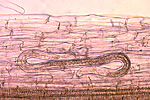
Figure 2 |
As their common name implies, lesion nematodes produce characteristic necrotic lesions (darkened areas of dead tissue) on the surface and throughout the cortex of infected roots (Figure 3). The lesions turn from reddish-brown to black and are initially spotty along the root surface. As the nematodes continue to migrate and feed within the roots, the lesions can coalesce to become large necrotic areas of tissue that may eventually girdle the root (Figure 4). Tissue distal to the lesion is frequently sloughed off. Severe damage from high populations of lesion nematodes can result in a stunted and necrotic plant root system (Figure 5). The extent of lesion formation can be accelerated during concomitant root invasion by other soilborne plant pathogens, and sometimes these interactions can develop into synergistic disease complexes. Lesion nematode damage to roots not only causes losses in yield (Figure 6), but also can cause losses in marketable quality of infected plant products (Figure 7).
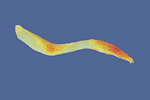
Figure 3 |
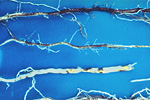
Figure 4 |
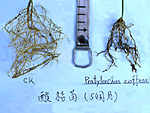
Figure 5 |

Figure 6 |

Figure 7 |
Potatoes:
The interaction of lesion nematodes (mainly P. penetrans - Figure 8) and Verticillium wilt fungi (mainly V. dahliae) results in a disease complex known as "potato early dying syndrome" that has become of increasing economic significance within the last decade. This syndrome can lead to premature vine death and severe yield losses that can become a limiting factor in potato production (Figure 9). Lesion nematodes can also infect potato tubers and, depending upon the species, can cause a scabby appearance with sunken lesions or dark, wart-like bumps that turn purple on tubers in storage.

Figure 8 |

Figure 9 |
Peanuts:
Although lesion nematodes can infect peanut roots and cause plant stunting and chlorosis, they are more often associated with damage to peanut pods and pegs ("stems" that extend underground to form the pods). Lesion nematodes (P. brachyurus in the southern U.S.) initially form small brown tunnels in peanut shells that expand into purplish-brown lesions with distinct boundaries (Figure 7). Extensive lesion formation, and pod and peg rot, can occur with concomitant invasion by other soilborne pathogens.
Pathogen Biology
Genus: Pratylenchus
The "type" (representative) species of this genus, P. pratensis was described in 1880 before the organization of the genus Pratylenchus in 1936, and the inclusion of Pratylenchus as the type genus in the family Pratylenchidae in 1949. Approximately 70 species have been described within this genus, although the designation of about one-third of the members as discrete species is a point of controversy among nematode taxonomists. The species of main importance on economic crop plants are P. brachyurus, P. coffeae, P. penetrans, P. scribneri, P. vulnus, and P. zeae. All postembryonic Pratylenchus life stages are worm-shaped (vermiform), and they are migratory endoparasites of plants (they feed and move within plants, mainly the roots). All life stages, including the adults, are microscopic and must be extracted from soil or plant material before they can be identified under a microscope.
Morphology:
As with most nematodes, the taxonomic designations of lesion nematode species are based upon morphological characters of the adult nematodes (Figures 1,2,and 8). Juveniles of Pratylenchus generally have the same characters as the adults (on a smaller scale), with the absence of fully developed reproductive organs (see Disease Cycle). The overall body shape of any nematode is determined by the pressure of its internal body fluids pushing against its strong, but flexible, outer "cuticle" (like a water balloon). The entire cuticle has a series of fine rings (annulations), like an earthworm, which allow the cuticle to bend at any point along the nematode's body. The cuticle is composed mainly of a structural protein, collagen, and the cuticle is molted four times to allow growth and maturation of the nematode. Adults of Pratylenchus are 300-900 µm long (depending upon species) and relatively stout (body length ÷ body width = 20-30, usually). The "head" of the nematode can be recognized by the presence of a short, dark spear with basal knobs (the "stylet") just inside the tip of the head. The stylet is hollow (like a hypodermic needle) and is protruded from the head when used by the nematode for penetrating plant tissues and feeding from cells. The very outer tip of the nematode head above the stylet (called the "lip"region) is characteristically flat and blackened in the genus Pratylenchus. In a relatively clear area just below the stylet can be seen a round, muscular pumping organ called the metacorpus - the metacorpus pumps substances (i.e. food and secretions) up and down the esophagus of the nematode. Just below the metacorpus is another relatively clear area that contains three esophageal glands that overlap the nematode's intestine on the ventral (stomach) side of its body. The intestine can be recognized as a fairly long dark area extending from the esophageal glands to the tail of the nematode.
Females:
The adult female can be recognized by an opening in the cuticle on the ventral side (the vulva) that is about 70-85% of the body length down from the head (depending upon the species) of the nematode (Figure 1). A clear row of cells (superimposed over the dark intestine) that get progressively larger leading down to the vulva is the female gonad that produces the eggs. Below the vulva near the tail is the opening of the intestine, the anus. The female tail tapers like a cone but it is rounded at the end (termed "conoid" in shape).
Males:
Pratylenchus males are generally slightly smaller and more slender than females, with the absence of the gonad and vulva. The males have a row of cells that form the testis. The testes look like the gonads in the female, but they empty at the anal opening. An easy, defining characteristic of males is the presence of two dark hooks (called "spicules") that are always present at the opening of the testis near the tail (Figure 10). The spicules are extruded and used during copulation. The tail of male is more pointed that the tail of females, and it often has two flaps of cuticle attached ("alae" = "bursa").
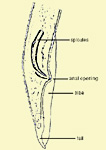
Figure 10 |
Disease Cycle and Epidemiology
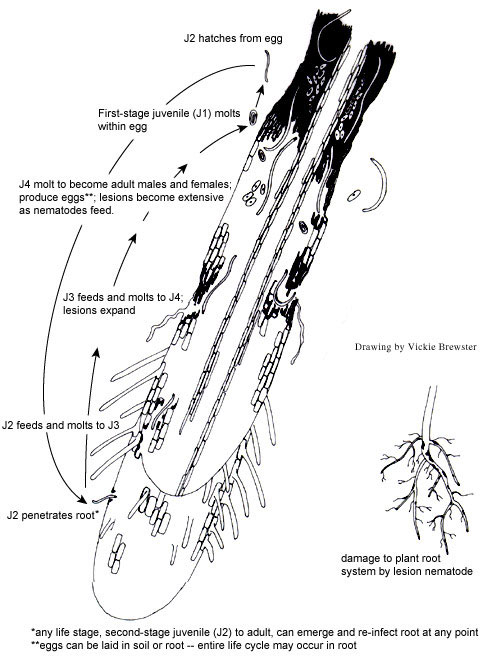
Disease Cycle
Epidemiology
Like all nematodes, lesion nematodes have six life stages -- egg, four juvenile stages, and the adult stage (Figure 11). The duration of the lesion nematode life cycle runs from 4-8 weeks, but this may be influenced by environmental conditions such asadequate temperature and moisture. After embryonic development within the egg to the first-stage juvenile (J1), the nematode molts to the second-stage juvenile (J2) and hatches from the egg. All juvenile and adult life stages of lesion nematodes are worm-shaped and motile, and all life stages (except the egg and J1) can infect plants. Adult males are numerous in some species and rare in others, and it is believed that lesion nematodes usually reproduce sexually (amphimixis) but can reproduce asexually (parthenogenesis). Although lesion nematodes can invade plant tubers, rhizomes, pods, and infrequently some aboveground plant structures, they are parasites of roots of all plant species attacked.
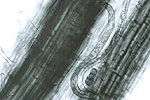
Figure 11 |

Figure 12 |
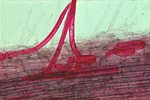
Figure 13 |
Lesion nematodes penetrate plant roots completely and migrate throughout the root tissue, mainly the cortex, as they feed. They can penetrate anywhere along the roots, but they show some preference for the region near the start of the root hair zone (Figure 12). They penetrate the root epidermis either intra- or intercellularly, but once inside, they migrate intracellularly (Figure 13). The nematodes feed on cells within the root, usually until the cells lyse and cavities are formed, and then the nematodes move forward within the root to feed on healthy plant cells (Figure 14). There are no elaborate plant cell modifications induced by lesion nematodes for feeding as there are with many sedentary plant-parasitic nematodes. The migration of the nematode within the root is usually ahead of the developing zone of necrosis that culminates in a visible lesion. Lesion nematodes at any life stage (except the egg and J1) can move in and out of the root into soil, and the entire life cycle (egg to egg) can also occur within a root (Figure 15). The nematodes can multiply within roots to populations up to 1,000-3,000 nematodes/gram of root (Figure 13)!! They can overwinter in infested plant parts or in soil at any life stage, although fourth-stage juveniles seem to be the optimal survival stage.
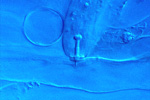
Figure 14 |

Figure 15 |
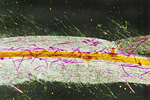
Figure 16 |
The wounds inflicted on plant roots and other belowground plant parts by lesion nematodes (Figures 3, 4, and 7) can serve as infection courts for pathogenic soil microbes, primarily fungi. This appears to be particularly true in disease complexes that involve lesion nematodes and wilt fungi such as Fusarium and >Verticillium. Complexes with Fusarium in which lesion nematodes are the initial invaders result in high populations of lesion nematodes, whereas the opposite timing seems to inhibit the accumulation of large populations of lesion nematodes (likely because they feed on living cells - i.e. they are "biotrophs"). The combination of P. penetrans and V. dahliae in potato induces a synergistic interaction that results in a disease syndrome termed "potato early dying". Neither pathogen induces severe damage at low populations, and reduction of nematode populations with nematicides has been reported to reduce the severity of the disease.

Figure 3 |

Figure 4 |

Figure 7 |
Epidemiology
As with most plant-parasitic nematodes in soil, lesion nematodes do not usually migrate more than 1-2 meters from the root zone that they infect. In plantings where root grafts may occur (i.e. fruit trees), the nematodes may travel from plant to plant through roots. In most cases, the movement of lesion nematodes is defined as "contagious" -- small foci of infested areas gradually enlarge to encompass significant areas of disease (Figure 17). Areas of disease become more pronounced in adverse environmental conditions such as water and nutrient stress, or if secondary pathogens simultaneously infect the roots. The spread of these nematodes within fields is usually accelerated by the cultural practices of the grower, such as soil cultivation. Lesion nematodes can be introduced to noninfested sites by poorly sanitized farm equipment and contaminated planting stock (i.e. tubers, seedlings). Since many species of Pratylenchus are endemic to native vegetation in many locations, new planting sites may already be infested with the nematode prior to cultivation.

Figure 17 |
Disease Management
The choice of management tactic to reduce lesion nematode damage depends upon many factors. All tactics require accurate diagnosis of the species and population levels of Pratylenchus as assessed from soil and root samples taken from any given field. Action thresholds vary among Pratylenchus species and crops depending upon geographic location, crop value, and the potential for disease complexes. Unfortunately, breeding for resistance to lesion nematodes is difficult, and thus, moderate resistance to lesion nematodes is presently limited to only a few cultivated crops (i.e. forage legumes, potato). Rotations to nonhost crops also offer limited opportunities to manage lesion nematode field populations since most Pratylenchus species have wide host ranges including both dicots and monocots. If the species of Pratylenchus is accurately diagnosed, and a suitable economic nonhost can be grown, rotations offer some promise as a management tactic. There are suggestions that microbial antagonists of lesion nematodes such as soil fungi can reduce population levels, but this has not been proven to be effective in production agriculture (Figure 18). The two most effective tactics for lesion nematode management remain sanitation and the use of nematicides.

Figure 18 |
Pre-plant options
The best way to manage lesion nematodes is to prevent their introduction into a field. Choosing an uninfested field site or choosing a nonhost rotation crop are two ways to avoid problems with lesion nematodes. Once lesion nematodes infest a field, it is highly unlikely that they can be eradicated. Inoculum levels can be reduced by moldboard plowing (turning over the soil layer) to expose infected roots to the elements. Planting stock should be monitored and certified to be free of lesion nematode infestation. This is especially important for seedlings of crops that will be grown perennially (i.e. fruits and ornamentals).
Pre-plant fumigation is probably the most effective tactic to reduce field population levels of lesion nematodes to below economic damage thresholds. Fumigants are usually applied by being chiseled below ground behind a tractor. The use of any chemical nematicide is dependent upon whether the nematicide is labeled for management of lesion nematodes in that crop, and if the predicted economic return on investment warrants the use of a nematicide. The multi-purpose fumigants (i.e. methyl bromide and mixtures with chlorpicrin) are rarely used specifically for lesion nematode control, although metham-sodium does provide good lesion nematode control in some cases. 1,3-dichloropropene (Telone II) is an effective and specific pre-plant soil fumigant for nematodes. Nonfumigant nematicides can also be applied pre-plant or at planting, but their efficacy may not rival that of the fumigants (Figure 19).

Figure 19 |
Post-plant options
Since many weeds are hosts for lesion nematodes, poor weed control will increase lesion nematode field populations and, most likely, increase crop damage. Destruction and removal of infested perennial crops, followed by soil fumigation, are drastic, but effective tactics to reduce subsequent lesion nematode-related damage. Nonfumigant nematicides represent the best tactic for remedial reduction of lesion nematode populations to reduce crop damage. Depending upon the nematicide label and crop, some of the nonfumigants include aldicarb (Temik), oxamyl (Vydate), fenamiphos (Nemacur), and carbofuran (Furadan). Some of these compounds offer systemic protection, and all are potent neurotoxins. The cost-effectiveness of nonfumigant nematicides is very dependent upon the crop, population level of nematodes, and environmental conditions. All nematicides are extremely toxic, especially the nonfumigants like Temik and Nemacur that are nerve poisons. Nematicides should only be applied by licensed applicators.
Significance
The first lesion nematode was isolated from a meadow and described as Tylenchus pratensis (Pratylenchus pratensis) by de Man in 1880. Several other lesion nematode species were described prior to the designation of the genus Pratylenchus by Filipjev in 1936. Most notable of these was the description of P. coffeae in 1898 (Zimmerman), a devastating pathogen of coffee (Figure 20), banana, citrus, and a number of fruit trees. Lesion nematodes were used by W. B. Mountain in the 1950's to first demonstrate conclusively that nematodes were pathogens of plants. He reared these migratory endoparasites in plant roots under aseptic conditions and observed the production of root lesions by the nematodes.

Figure 20 |
At present, more than 70 species of Pratylenchus have been described, with a combined host (plant) range of greater than 400 crop plant species. The lesion nematodes rank third behind root-knot and cyst nematodes as the nematodes of greatest economic impact in crops worldwide. This is not only due to their wide host range, but their distribution in almost every temperate and tropical environment. Crops of primary economic importance that are attacked by lesion nematodes include potato, coffee, banana, rice, corn, peanut, forage legumes, and many fruits.
Selected References
Barker, K.R., G.A. Pederson, and G.L. Windham. 1998. Plant and Nematode Interactions. ASA, CSSA, SSA Publishers, Madison, WI. 771p.
Dropkin, V.H. (1980). Introduction to Plant Nematology. John Wiley & Sons, NY, 293 p.
Evans, K., D.L. Trudgill, and J.M. Webster, eds. (1993). Plant Parasitic Nematodes in Temperate Agriculture. CAB International, Cambridge, UK, 648 p.
Loof, P.A.A. 1991. The family
Pratylenchidae Thorne 1949. Pp. 363-422
In Nickle, W.R., ed. Manual of Agricultural Nematology. Marcel Dekker, Inc., NY.
MacGuidwin, A.E., and D.I. Rouse. 1990. Role of Pratylenchus penetrans in the potato early dying disease of Russet Burbank potato. Phytopathology 80:1077-1082.
Rowe, R.C., J.R. Davis, M.L. Powelson, and D.I. Rouse. 1987. Potato early dying: causal agents and management strategies. Plant Disease 71:482-489.
